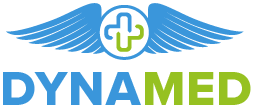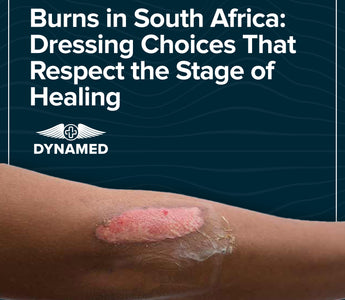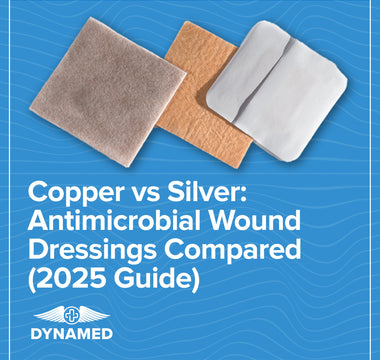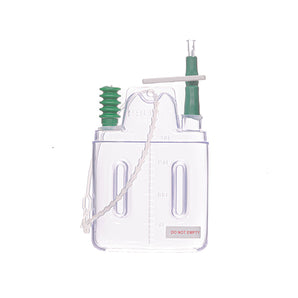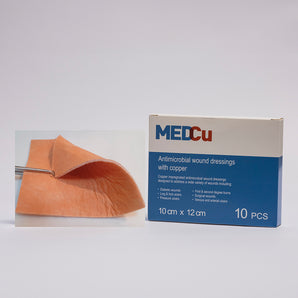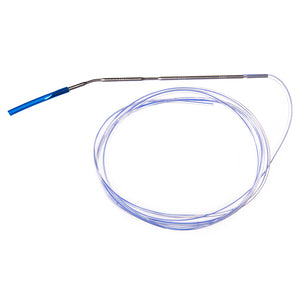Introduction
Burn injuries are a common challenge in South Africa, from household accidents to workplace incidents. Treating burns requires more than simply covering the wound, the dressing must match the stage of healing. Using the right product at the right time not only reduces infection risk but also improves patient comfort and speeds recovery. This guide explores the most effective dressings for burns wound care in South African settings, with practical insights for clinics, hospitals, and trauma units.
Key Points (Quick Takeaways)
-
Hydrogel dressings for burns provide moisture, cooling, and pain relief in the early stages.
-
Foam dressings help manage exudate and protect fragile new tissue.
-
Antimicrobial dressings (silver or copper) reduce infection risk in burns with bacterial colonisation.
-
Dressing selection should follow the stage of healing: acute, intermediate, and recovery.
- Outpatient burns care in South Africa requires longer-wear dressings to reduce travel burdens.
Understanding Burns and Healing Stages
Acute Phase (First 24–48 Hours)
-
Goal: Pain relief, cooling, and moisture restoration.
- Best option: Hydrogel dressings for burns to cool tissue, soothe pain, and prevent dehydration.
Intermediate Phase (Days 2–10)
- Goal: Manage exudate and protect from infection.
- Best options: Foam dressings for absorption; antimicrobial silver or copper dressings if infection is a concern.
Recovery Phase (After 10+ Days)
- Goal: Support re-epithelialisation and reduce scarring.
- Best options: Low-adherence foam or film dressings that protect fragile new skin.
Hydrogel Dressings: Relief and Moisture
Hydrogels are water-based dressings that cool and hydrate burns. They are especially valuable in South Africa’s trauma units and rural clinics, where quick pain relief and moisture balance are critical.
- Reduce immediate pain.
- Promote autolytic debridement of necrotic tissue.
- Provide a moist environment for faster epithelialisation.
Foam Dressings: Absorption and Protection
As burns begin exuding fluid, foam dressings provide excellent absorption and cushioning.
- Absorb exudate while preventing leakage and maceration.
- Provide a protective barrier against physical trauma.
- Suitable for both inpatient and outpatient burns management.
Foam Plus Antimicrobial Agents
Foams embedded with silver or copper combine exudate management with infection control, making them ideal for burns at risk of colonisation.
Antimicrobial Dressings: Infection Control in Burns
Infection is one of the biggest threats to burn patients. Antimicrobial dressings add protection at critical healing stages.
Silver Dressings
- Effective against a broad spectrum of bacteria.
- Recommended for burns with clear infection or heavy colonisation.
Copper Dressings
- Provide antimicrobial activity and accelerate wound healing.
- Useful for chronic or slow-healing burns in both hospital and outpatient settings.
Outpatient Burns Care in South Africa
In rural areas, patients may travel long distances to clinics. Dressing choices must respect these realities:
- Longer wear times reduce the need for frequent changes.
- Hydrogel sheets and foam dressings can stay in place for days, minimising patient burden.
- Training caregivers on dressing monitoring ensures continuity of care outside hospitals.
Conclusion
Burns care in South Africa demands a stage-based approach. Hydrogels provide immediate relief, foams manage exudate, and antimicrobial dressings reduce infection risk. For trauma units, burns clinics, and rural facilities, stocking a combination of these dressings ensures patients receive the right treatment at the right stage of healing. By aligning burn dressing choices with the realities of South African healthcare, clinicians can deliver faster healing and safer outcomes.
Dynamed Pharmaceuticals
Phone: 0861 00 00 43
Website: dynamed.co.za
Email (Sales): sales@dynamed.co.za
Email (Info): info@dynamed.co.za
Google Maps: Find us here
FAQs
1. What is the best dressing for burns in the first 48 hours?
Hydrogel dressings are recommended for early burn care, as they provide moisture, cooling, and pain relief.
2. When should foam dressings be used for burns?
Foam dressings are best in the intermediate healing stage, when exudate needs to be absorbed and the wound requires protection.
3. Are antimicrobial dressings always necessary for burns?
Not always. They are recommended when burns are infected or at high risk of bacterial colonisation.
4. What’s the difference between silver and copper dressings for burns?
Silver focuses on infection control, while copper adds both antimicrobial protection and tissue regeneration benefits.
5. How often should burn dressings be changed?
Depending on the product and wound condition, dressings may last from 24 hours up to several days. In outpatient care, longer-wear dressings are preferred.
6. Where can South African clinics source burn dressings?
ISO-certified local suppliers like Dynamed provide hydrogel, foam, silver, and copper dressings for hospitals, trauma units, and rural healthcare facilities across the SADC region.
